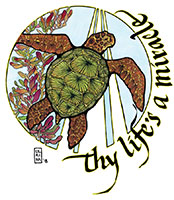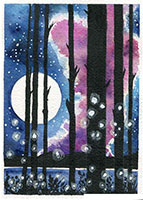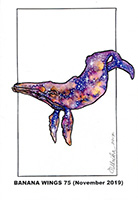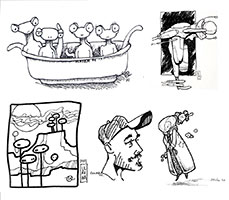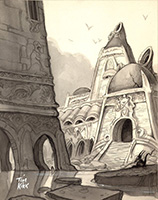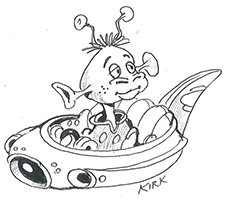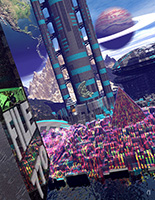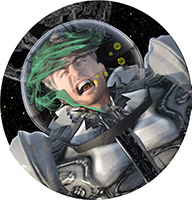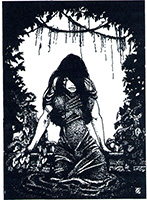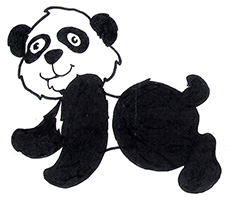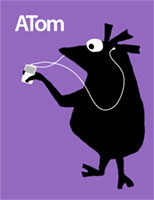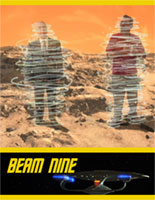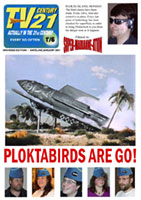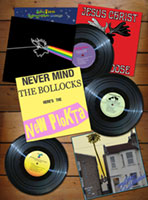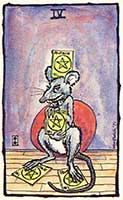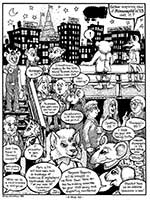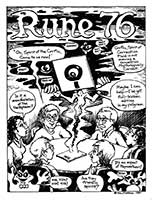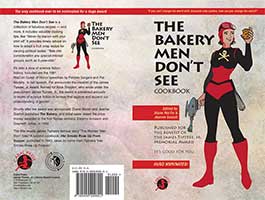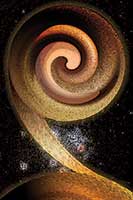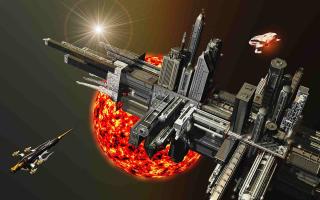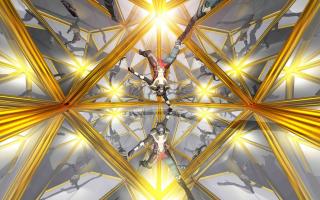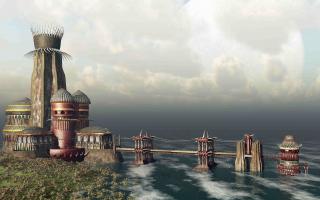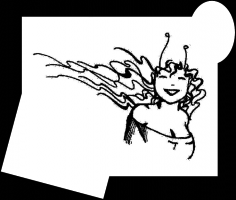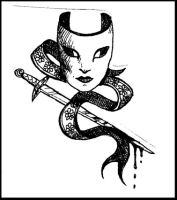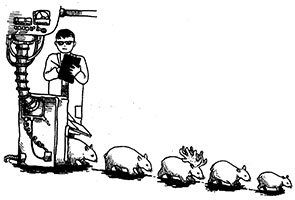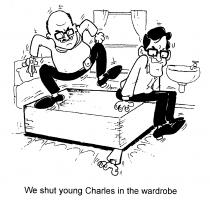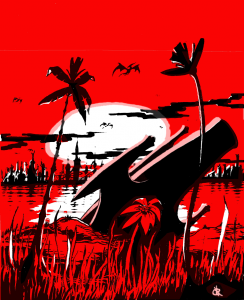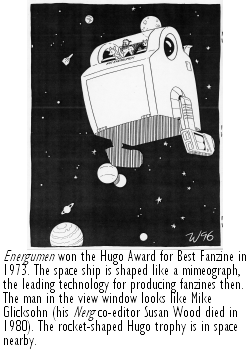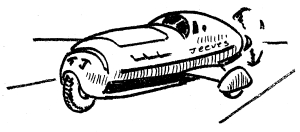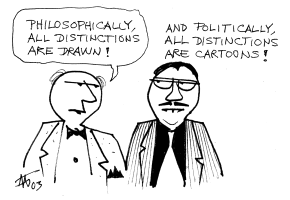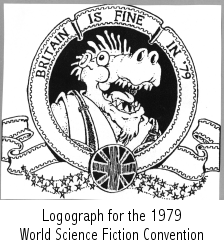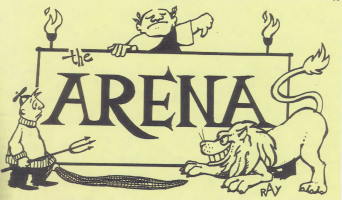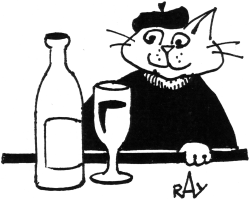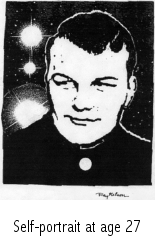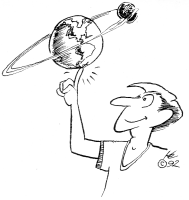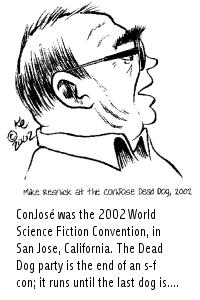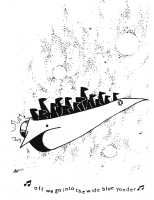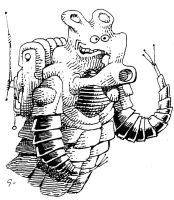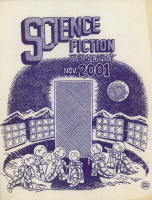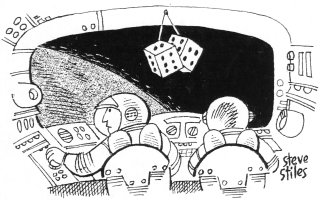The annual Rotsler Award, established in 1998 and named for Bill Rotsler (1926-1997), is presented each year for wonder-working with graphic art in amateur publications of the science fiction community. It is sponsored by the Southern California Institute for Fan Interests, carries a $300 honorarium, and is ordinarily announced at Loscon, the Los Angeles science fiction & fantasy convention held over the U.S. Thanksgiving Day weekend in November.
 Bill Rotsler knew everyone and did everything. He went house-hunting with Marilyn Monroe. He wrote science fiction. He sculpted with welded steel rods. He celebrated the West Coast Science Fantasy Conference (better known as Westercon) as his birthday. In the fan community he was best known for graphic art, mostly in the amateur publications by fans, for fans, which we call fanzines (a name coined by Russell Chauvenet in the 1940s.)
Bill Rotsler knew everyone and did everything. He went house-hunting with Marilyn Monroe. He wrote science fiction. He sculpted with welded steel rods. He celebrated the West Coast Science Fantasy Conference (better known as Westercon) as his birthday. In the fan community he was best known for graphic art, mostly in the amateur publications by fans, for fans, which we call fanzines (a name coined by Russell Chauvenet in the 1940s.)
Rotsler won the Hugo Award (the highest achievement in the science fiction community) as Best Fan Artist on five separate occasions: in 1975, 1979, 1996 (when he also won the Retrospective Hugo for 1946) and 1997, a remarkable span. His cartoons were deft, his serious drawing fine, his fluency downright breathtaking.
The Rotsler Awards are coordinated for SCIFI by Board member Elizabeth Klein-Lebbink. The current judges are John Hertz, Sue Mason, and Suzanne ‘Suzle’ Tompkins.
Rotsler Award Winners
Click the year/winner line to open up full details about each winner, including select images by each artist; click on the thumbnails to see larger versions of the illustrations.
All images are used with kind permission of the artist.
Biography and illustrations coming soon!
Ulrika Anderson O’Brien is a Seattle-area fanzine fan, fanartist, conrunning fan, “gadfly and curmudgeon.” She uses Akirlu as a fan name and online handle. She chaired Potlatch 15, Potlatch 22, Corflu 39, and Prolog(ue). She was part of the Corflu 26 committee and has worked on numerous regionals and Worldcons. She has been a member of LASFS, Icarus, S.P.E.C.T.R.E and fwa. Her APAs include APA-L, LASFAPA, Myriad and TurboAPA. Born in Sweden, Ulrika immigrated to the U.S. as a child. She’s married to fellow fan Hal O’Brien. – From Fancyclopedia 3
We first met Tim Kirk through paintings illustrating The Lord of the Rings for his Master of Fine Arts degree; thirteen of which were published in the Ballantine Books’ 1975 Tolkien Calendar. He has won five Hugo Awards as Best Fanartist (a finalist nine times). With Ken Keller he designed the first cold-cast resin base for the Hugos (34th Worldcon). In his pro career he contributed greatly to DisneySea in Japan and designed the Seattle SF Museum. Whimsy and melancholy are both in his work.
Drawing men, women, monsters, and wonders, Alan White was already well-known when he contributed to the 42nd Worldcon’s Program Book; nor has he ceased creating. Recently he has been part of Crazy Las Vegas Fandom. He was Artist Guest of Honor at Loscon 39 (Los Angeles), and won the Fan Activity Achievement (FAAn) Award for Best Artist in 2019. Like other good artists he chooses what will best suit his intentions, and has used line drawings, computer-aided compositions, monochrome, and color in his works.
Alison Scott gained renown as layout wizard and cover artist for the British fanzine PLOKTA, “the journal of superfluous technology”, PLOKTA being an acronym for Press Lots Of Keys To Abort; it won two Hugos as Best-Fanzine. Scott won the United Kingdom’s Nova Award as Best Fanartist three times. She chaired the 46th and 69th Eastercon (U.K. national convention, held Easter weekend) and was Fan Guest of Honour at the 71st.
Ken Fletcher’s drawings have long been part of Rune and other amateur publications. In 1966 he co-founded the Minnesota Science Fiction Society (Minn-StF; stf, pronounced “stef”, from Hugo Gernsback’s word scientifiction). By 1976, when he co-founded Vootie, “the Fanzine of the Funny-Animal Liberation Front”, he was known particularly for anthropomorphic cartoons. He and his wife Linda Lounsbury were Down Under Fan Fund (DUFF) delegates, attending the 1979 Australian national SF convention. Science Fiction Five-Yearly, published on time for sixty years, carried the long-running serial !Nissassa by Nalrah Nosille (backward only in that sense), with recent chapters illustrated by Fletcher.
Jeanne Gomoll (“go-MOLL”) created the logographs for the Tiptree Award and the fanziners’ convention Corflu. She did many covers and interiors for Janus, which she co-edited; it won two Fan Activity Achievement Awards and was three times a Hugo finalist for Best Fanzine. She herself has twice been a Hugo finalist for Best Fanartist. In 1987 she was the Trans-Atlantic Fan Fund (TAFF) delegate, attending the 45th Worldcon; she was a Guest of Honour at the 72nd Worldcon (also in the U.K.) and did the covers for its Pocket Programme Guide. She co-founded the feminist SF convention Wiscon and served on the board of its sponsoring organization over four decades.
Martin James Ditmar Jenssen, known among fans as “Dick” or “Ditmar,” got his first look at science fiction art (a painting of Saturn by Chesley Bonestell) when he was eight. Immediately his imagination kicked into gear, and he found himself able to visualize variations in the color, the point of view, and other details or hardware. By the time he was a teenager, he was producing art for his friends’ mimeographed fanzines, which involved using a metal stylus to draw on waxed master sheets.
Seeing for the first time Morris Scott Dollens’ black-and-white space and planetary scenes made him want to learn another technique, scraperboard. This was a thin white clay bonded to a cardboard base, which could be covered in India ink, then scraped away with a scalpel to reveal the white underneath. Ditmar’s efforts in this vein were published on the covers of Australian fanzines.
The advent of computers gave Ditmar a new tool for producing exotic color compositions. “Since I usually always wanted to redo what I had created, in order to reorganize the compositional elements, and/or the coloring, and/or the elements themselves, it seemed that graphic packages would be ideal. Software which would allow me to generate three-dimensional objects in a virtual world, to organize their spatial distribution and relations, to color them as I wished, to manipulate them in unreal ways.” And digital and online fanzine publishers, freed from the cost of printing color art on paper, responded with approval, publishing several elaborate folios of these images.
Asked whether there should be an accent mark over the i, Teddy Harvia said “That’s the Spanish side of the family. We on the Finnish side don’t use one.” He has won five Hugos as Best Fanartist, the Science Fiction Chronicle readers’ poll four times, and the Southern Fandom Confederation’s Rebel Award. He was long associated with the fanzine Mimosa. Some of his creatures, like Chat the Fourth Fannish Ghod (the h is an age-old, or h-old, touch of comedy in fanzines), and the Wing Nuts, re-appear now and then in his work. Other creatures we know not if we shall see again. Keep watching the stars.
Sue Mason is celebrated for her work in the British fanzine PLOKTA, “the journal of superfluous technology” (PLOKTA an acronym for Press Lots Of Keys To Abort). Besides pen and ink, she does pyrography, burning designs into a surface, usually wood, leather, or paper. She has won two Hugos (a finalist nine times) and seven Novas as Best Fanartist. In 2000 she was the Trans-Atlantic Fan Fund (TAFF) delegate, attending the 58th Worldcon, and she was Master of Ceremonies for the Masquerade (our on-stage costume competition) at the 63rd. The Minnesota Science Fiction Society published her chapbook I Want to Be a Celtic Death Goddess When I Grow Up.
Quick and prolific – some artists are, some aren’t. Jim Barker was a Guest of Honour at the 31st Eastercon (U.K. national convention, held Easter weekend). In 1979 he and Chris Evans published The Best of Elmer T. Hack, a collection of Barker comic strips from Vector recording the history of a fictional SF author, many of which featured cameos of real pros. He has been a Hugo finalist as Best Fanartist and won a Checkpoint poll. A member of the Cartoonists’ Club of Great Britain, he says “you have to draw the line somewhere.”
Ross Chamberlain illustrated the 1971 edition of The Enchanted Duplicator and did cover art for the three-volume Fanhistorica Press edition of A Wealth of Fable. He has been in the apas (amateur press associations) APA-F, APA-Q, APA-V, FAPA, and TAPS. While in New York he was a member of the Fanoclasts, FIStFA, and the Brooklyn Insurgents. Going west, he became one of the Las Vegrants (interlingually redundant, sorry). He was masterly with mimeograph stylus and shading plate, since Photoshop arrived he has used that too.
For 2011 the judges decided upon giving the Award to D West. However, he declined. The judges therefore determined there would be no 2011 Rotsler Award.
Stu Shiffman (1954-2014) was the 1981 Trans-Atlantic Fan Fund delegate. Then dwelling in New York, he later made the Great Northwest Pilgrimage to become a resident of Seattle.
Shiffman had eleven Hugo Award nominations as Best Fanartist. He was a Guest of Honor at Minicon XX and Wiscon XII, and had a recipe in The Bakery Men Don’t See (1991). Historical interests and strange animals were often involved in his drawings. Besides science fiction, he was a fan of folk music and Sherlock Holmes. He was also a judge of the Sidewise Awards.
Dan Steffan, of Portland, Oregon, won the Readercon award for the design of Science Fiction Eye. As of July 2010 he has won the Fanzine Activity Achievement (FAAn) award as Best Fanartist four times, and has had one Hugo Award nomination. He was the Trans-Atlantic Fan Fund delegate in 1995.
His imagination, his marshalling of detail, and his poignant satire have kept his reputation high for decades. His work is always part of any conversation about excellence in fanzines. (You’ll see he sometimes signs his name on three lines, DAN STEF FAN. Hugo Gernsback’s old word scientifiction is still with us, stf for short, pronounced “stef.”)
Toronto-area artist Taral Wayne has been nominated seven times for a Hugo Award as Best Fanartist. Writing is also an art; he is a noted fanwriter. History may also be an art; he is a noted fanhistorian. He was Fan Guest of Honour at Anticipation, the 67th World Science Fiction Convention, in Montréal. However, none of these interesting facts is within the scope of the Rotsler.
Taral’s work is by turns serious, sexy, and satirical, with a fluent line and strong composition. At home with space equipment and strange creatures, he was also drawing anthropomorphic animals long before most in North America had heard of animé or manga.
Terry Jeeves (1922-2011) was of First Fandom, that happy band who became active fans at least as early as the first World Science Fiction Convention (1939). He wrote for fanzines, he sent drawings to fanzines; for over forty years he published his own fanzine Erg. He had a way with people, creatures, and machines. They may appear together. Some are the humanoids we have come to know as Soggies. Al Capp fans say these resemble Shmoos. Perhaps. As with many fanartists, Jeeves’ work has a whimsical touch. He could be comic, satiric, poignant; often understated. He was an Englishman.
Alexis Gilliland has a distinctive witty style that has long enriched amateur publications in the science fiction community.
The one color piece included is from Bruce Pelz’ Fantasy Showcase Tarot Deck (1980). Each card was by a different fan or pro artist, some majestic, some earthy, some wry. Some of the other Rotsler winners did these too. Gilliland’s is in a voice quite unlike what he is mostly known for.
Gilliland has also published s-f, but his pro activity is not within the scope of the Rotsler Award. In fact he has four times won the Hugo Award as Best Fan Artist, but that is not within the scope of the Rotsler either. The Hugos, highest achievement award in the s-f community, are given for work in the previous calendar year. The Rotsler is for long-time wonder-working. And while some Rotsler winners have won Hugos, some have never been nominated for them.

